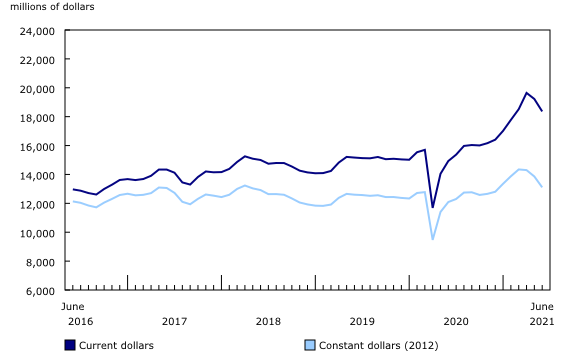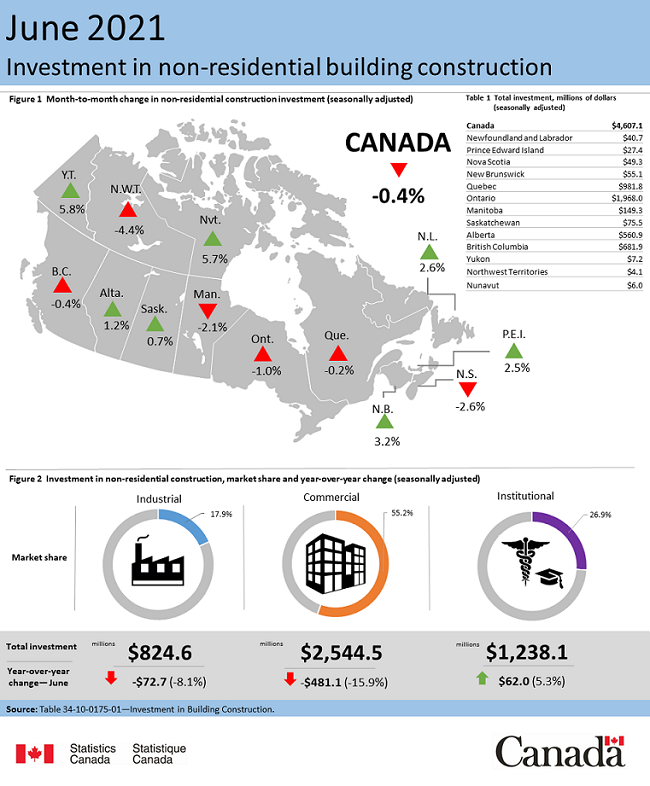Investment in building construction, June 2021
Archived Content
Information identified as archived is provided for reference, research or recordkeeping purposes. It is not subject to the Government of Canada Web Standards and has not been altered or updated since it was archived. Please "contact us" to request a format other than those available.
Released: 2021-08-12
$18.4 billion
June 2021
-4.5% 
(monthly change)
Investment in building construction decreased 4.5% to $18.4 billion in June. Both residential and non-residential construction investment were down following a period of sustained growth from November 2020 to April 2021.
On a constant dollar basis (2012=100), investment in building construction declined 5.4% to $13.1 billion in June.
Residential investment cools off for a second month
Following a 3.0% decrease in May, residential construction investment fell 5.8% in June to $13.8 billion.
Investment in single-family homes remained well above pre-COVID-19 levels, despite falling 7.3% in June to $7.5 billion. Ontario and Quebec pulled single-unit investment down in June, after Ontario led national growth since May 2020.
Multi-unit construction investment was down 3.8% to $6.2 billion in June, with more than half of the provinces posting declines. Quebec reported the largest decrease mainly in the city of Montréal, followed by Ontario and British Columbia.
First Non-residential construction decline in six months
After posting slight increases for the last six months, non-residential construction investment edged down 0.4% to $4.6 billion in June, reflecting declines in commercial and industrial investment.
Commercial construction investment declined 1.0% to $2.5 billion. The largest drop stemmed from Ontario, down 2.2% as projects such as storage facilities in the cities of Ajax and Brampton began to slow down after peaking earlier this year.
Industrial construction investment was down 1.2% to $825 million in June. Minimal growth in four provinces was not enough to counter the decline.
Institutional investment increased for the eighth consecutive month, up 1.3% to $1.2 billion. Ontario led the way, advancing 2.8% to $430 million, aided by projects such as a long-term care home in Mississauga. Quebec, Alberta and New Brunswick also reported gains.
Fourth consecutive quarterly increase
Total investment in building construction increased 7.3% to $57.2 billion in the second quarter of 2021.
Residential construction surpassed $40 billion for the first time ($43.4 billion), with an increase of 9.3% compared with the first quarter. The strength of the residential sector this quarter continued to stem from single-unit investment, specifically in the larger provinces.
Non-residential investment posted a slight increase in the second quarter, up 1.5% to $13.8 billion, yet remained slightly below the same quarter in 2020. Institutional investment reported a 4.8% increase, with the most growth coming from Ontario and Quebec. Quebec posted its highest investment in this component since the series began in 2010, up 6.5% to $988 million and was boosted by construction of secondary schools, long-term care homes and hospitals.
Industrial construction investment was up 1.1% despite declines in more than half of the provinces. Quebec and Ontario led the growth, with Quebec 35.7% higher than the second quarter of 2020.
Commercial investment inched forward 0.2% this quarter, remaining below pre-COVID-19 levels. Ongoing projects in Ontario and Alberta helped to offset declines in Quebec and Manitoba.
For more information on housing, please visit the Housing Statistics Portal.
Note to readers
Based on the extraordinary events and business disruptions related to the COVID-19 pandemic, Statistics Canada continues to make adjustments to the models used to estimate investment in building construction. As a result of these adjustments, there may be larger-than-normal revisions to the data.
Revision
Unadjusted data for the current reference month are subject to revision based on late responses. Data for the previous month have been revised. Seasonally adjusted data for the previous two months have also been revised.
Data presented in this release are seasonally adjusted with current dollar values unless otherwise stated. Using seasonally adjusted data allows month-to-month and quarter-to-quarter comparisons by removing the effects of seasonal variations. For information on seasonal adjustment, see Seasonally adjusted data – Frequently asked questions.
Monthly estimates in constant dollars are calculated using quarterly deflators from the Building Construction Price Index (Table 18-10-0135-01). Typically, the first two months of a quarter use the previous quarter's price level and are revised when the new quarterly price index becomes available.
Detailed data on investment activity by type of building and type of work are now available in the unadjusted current dollar series.
Prior to January 2018, building permits for cottages with a value greater than $60,000 were automatically reclassified to the structure type "single." Beginning in January 2018, regardless of value, building permits received from municipalities coded as cottages remain classified as a cottage.
Effective November 23, 2018, Table 34-10-0175-01 contains data on both the residential and the non-residential sectors. It replaced tables 34-10-0010-01, 34-10-0011-01 and 34-10-0012-01.
Next release
Data on investment in building construction for July will be released on September 13.
Products
A study titled "Price trends and outlook in key Canadian housing markets" looks at where the housing market was at the onset of the COVID-19 pandemic, sheds light on what has happened since then and explores the challenges facing the Canadian market going forward.
Statistics Canada has a "Housing Market Indicators" dashboard. This web application provides access to key housing market indicators for Canada, by province and by census metropolitan area. These indicators are automatically updated with new information from monthly releases, giving users access to the latest data.
Contact information
For more information, or to enquire about the concepts, methods or data quality of this release, contact us (toll-free 1-800-263-1136; 514-283-8300; STATCAN.infostats-infostats.STATCAN@canada.ca) or Media Relations (613-951-4636; STATCAN.mediahotline-ligneinfomedias.STATCAN@canada.ca).
- Date modified:





